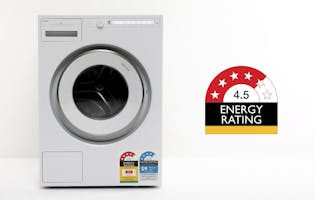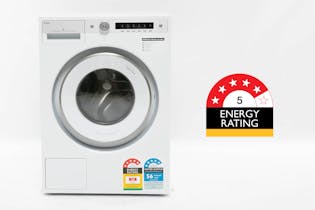Front or top loader? Seven myths debunked
We’ve been putting washing machines through the wringer since the 1960s, and in that time, a pattern has emerged – front loaders perform better.
Our tests prove top loaders are tougher on fabrics, guzzle water and don’t remove dirt that well.
On average, front loaders are ahead in all our tests apart from rinsing – but you’d expect good rinsing from top loaders as they use such stupendous amounts of water.
Of course, clean laundry isn’t the only key to long-term happiness with your washing machine. You’ll also be hoping for years of hassle-free operation.
Our latest reliability and owner satisfaction survey, which included 1,316 top loaders and 2,058 front loaders, showed similar reliability for both types, with 84% of top loaders and 87% of front loaders remaining fault free in the first 5 years of ownership.
However, there was a marked difference in satisfaction, with front-loader owners significantly happier with their purchase – 77% reported being very satisfied, compared with 66% of top-loader owners.
Why then, when it’s clear front loaders are better, do people still buy top loaders?
Because, for some people, a front loader simply isn’t the right choice.
At Consumer, we’re all about helping you identify the product that best suits your circumstances. But if you’ve always assumed a front loader wouldn’t work for you, you might be surprised.
Here, we dispel some misconceptions about both types of machines.
'Front loaders are too small’
If you have jumbo-sized piles of laundry, don’t assume your only option is a top loader.
The largest domestic washing machines are 18kg front loaders. The biggest top loaders available are 14kg.
'Only a top loader would fit’
If space is tight (less than 65cm, which is the minimum needed for a standard 60cm-wide machine with a few centimetres’ wiggle room), you’ll have no choice but to get a top loader.
It’s slim pickings though, as most top loaders are at least as wide as the average front loader. They’re also generally deeper and always taller.
A front loader is best for using space efficiently, as it can double as a benchtop or allow a dryer to be conveniently mounted above.
'Front loaders take too long’
Front loaders generally take longer to wash, but their cycles are often not as long as stated in the manual (when the load’s small, the programme usually gets shorter automatically).
Most synthetic fabrics are more robust than cotton, so using a typical “mixed” cycle will be faster. But if you’re in a hurry, use the “quick” setting. Or you could delay the start, and let the machine do its thing while you’re out, then hang your laundry out later.
'Front loaders are too expensive’

We certainly have more expensive front loaders in our tests than top loaders. But it’s also true that you don’t have to spend megabucks to get a good front loader – you’ll see from the graph that there are plenty of front loaders priced between $850 and $2,000 that have excellent performance scores.
Meanwhile, similarly priced top loaders are way down on performance.
You’ll also notice that the trendline for front loaders is nearly horizontal, indicating that performance does not increase with price for our tested models (although you’re likely to get larger capacity or additional features, such as auto-dosing and wi-fi connectivity, for your extra investment).
'Front loaders get yucky’
The rubber seal of a front loader’s door can get mouldy. But you change the oil in your car and remove the lint from your tumble dryer, so it shouldn't be a hassle to run a maintenance cycle and wipe down the rubber door seal.
It’s not just front loaders that require maintenance washes. Scrud (the waxy build-up that occurs when fabric softener meets detergent) can affect both front and top loaders. Some machines have cleaning cycles, or else you can run a long, high-temperature cycle without detergent and clothes to get rid of it.
'Top loading is more convenient’
“You can’t add anything to a front loader” is a common complaint – but that was then.
These days, several manufacturers make front loaders with an “add item” hatch, and some machines can be paused to add garments.
As for people with mobility issues, it’s true they may find a top loader easier to access, but a pedestal can raise a front loader by up to 67cm, making the drum more accessible. Also, pedestals usually include a drawer, which is handy when you can no longer use the top of the machine as a work or storage surface.
'Front loaders use heaps more power’
Our annual running cost figures assume you do one “normal” wash cycle a day, at 25¢ per kilowatt hour. This makes front loaders seem power-hungry, but actually the difference between top- and front-loader running costs for a “normal” cycle aren’t that big.
On average, front loaders cost $22 per year to run. That’s compared to $14 per year for top loaders. So, you’re looking at an extra $8 a year for a front loader. Not that much extra really. If you save up your washing for a few days, and do larger loads less often, then it’ll cost even less.
When it comes to being water wise, though, front loaders can’t be beat. At the time of writing, the average water used per wash by our front loaders is 58 litres. For top loaders it’s over twice that amount, at a whopping 124 litres! For those of you on metered water this could be a significant extra cost.

We can't do this without you.
Consumer NZ is independent and not-for-profit. We depend on the generous support of our members and donors to keep us fighting for a better deal for all New Zealanders. Join us today to support our work.
We've tested 178 washing machines.
Find the right one for you.


.jpg&w=315&q=75)
Member comments
Get access to comment